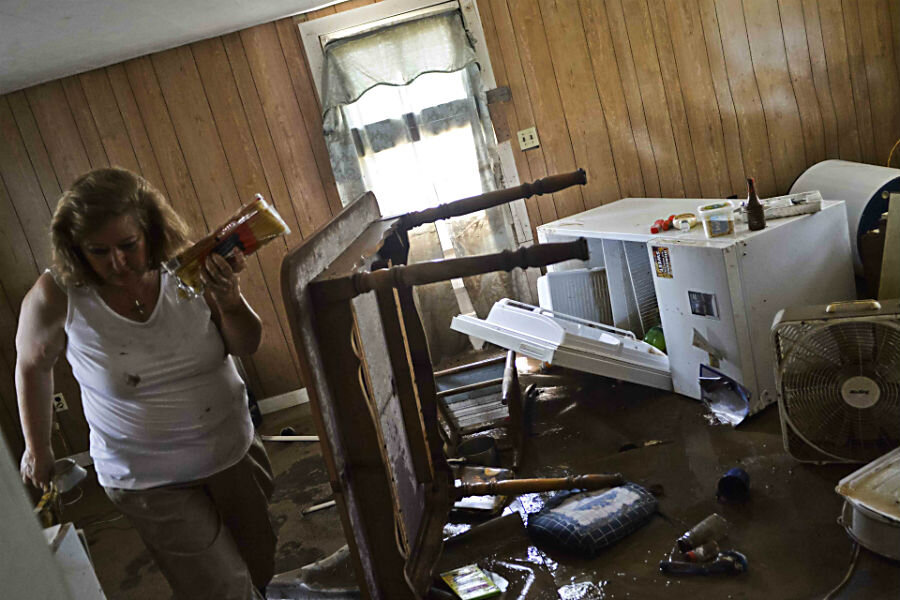West Virginia: More rain in the forecast
Loading...
| Ansted, W. Va.
More heavy rains are expected in West Virginia, where floodwaters have killed at least 25 people in the past week.
More than 20 counties were under a flash flood watch Monday. The National Weather Service said downpours were possible in many areas already ravaged by flooding, including Kanawha and Nicholas counties. The forecast also included hardest-hit Greenbrier County, where 17 people have died and floodwaters have yet to recede.
Many residents were still trying to come to grips with ruined property and lost lives before the latest rounds of storms hit.
Gov. Earl Ray Tomblin's administration still believes there are people missing in Greenbrier County, chief of staff Chris Stadelman said.
On Sunday, dozens of residents from flooded-out Rainelle remained at a shelter more than 25 miles away at the Ansted Baptist Church, where singing from inside mixed with the bustle of activity outside.
The church's gymnasium has been converted to a shelter. The church also is a drop-off point for donated goods as well as a makeshift kennel for dog owners.
For now, it's home for Jerry Reynolds, his wife, Janice, and his brother, Marcus Reynolds.
Janice Reynolds said she drove back to Rainelle on Saturday to survey the damage. She said her home was destroyed, a vehicle was lost in the floodwaters and the community "smelled like death."
Jerry Reynolds says the flood was "the worst thing I've ever seen." But as he sat in his car at the shelter, he declared that "we're survivors. We'll make it."
Marcus Reynolds even found a bit of humor amid the sorrow.
"While we're at it, would you be interested in any oceanfront property?" he said. "I understand there's some available."
Bill Kious of Rainelle was asked how those at the shelter, many of them on modest incomes, were able to laugh.
"Frankly, because we've lived a rough lifestyle," Kious said. "It's a nature to us that we can't get rid of."
Rick Lewis of the Nuttall Fire Department said 129 people were staying Sunday at the church gymnasium. Many more Rainelle residents were sent to other shelters, he said.
Among those taking advantage of the shelter's kennel was T.J. Parker of Rainelle and his pet Titan.
Parker said he and Titan had to swim four blocks to safety. Along the way, he stopped to rescue an elderly man calling for help and brought him through floodwaters to a fire department. Parker said he had to go under water and hold his breath to support the man, then come up for air.
"I realize that sounds crazy, but you have to do what you have to do at that time," Parker said.
Volunteer Randy Halsey said the donated items at the church were heading specifically to Rainelle. He said it was difficult to estimate how many items had been donated because "as soon as it comes in, it's going right back out."
Authorities have yet to start sizing up the flood damage in West Virginia. But it is drawing comparisons to November 1985 floods that remain the state's most expensive natural disaster with more than $570 million in damage.
The 1985 floods left 47 dead in West Virginia, more than half of them in Pendleton and Grant counties. The Potomac River at Paw Paw crested 29 feet above flood stage. More than 3,500 homes, 180 businesses and 43 bridges statewide were destroyed. Twenty-nine counties were declared federal disaster areas.
"This is the worst I've ever seen," said Fayette County Sheriff's Sgt. Bill Mooney, who served in the National Guard during massive floods in 2000-01. "Nobody expected 7 inches of (rain) in three hours."
About 18,000 homes and businesses remained without power Sunday. It marked the first day people can apply for Federal Emergency Management Agency aid in Greenbrier, Kanawha and Nicholas counties.
President Barack Obama's signature Saturday on the federal disaster declaration lets residents in the three counties get aid for temporary housing and home repairs, receive low-cost loans to cover uninsured property losses, and qualify for other assistance for individuals and business owners. Federal money to help the state and local governments is also available on a cost-sharing basis. FEMA officials were in the state to begin assessing the damage to infrastructure, homes and other property.
The floods prohibited Georgia resident David Stephens from doing contract work spraying weed killer to eliminate vegetation around poles. He saw someone buying water at a store and asked where the water was heading. So he went to the church in Ansted to help move donated supplies along.
"I just want to do whatever I can to help," Stephens said.
__
Raby reported from Charleston, West Virginia. Associated Press writer Jonathan Mattise contributed to this report.







